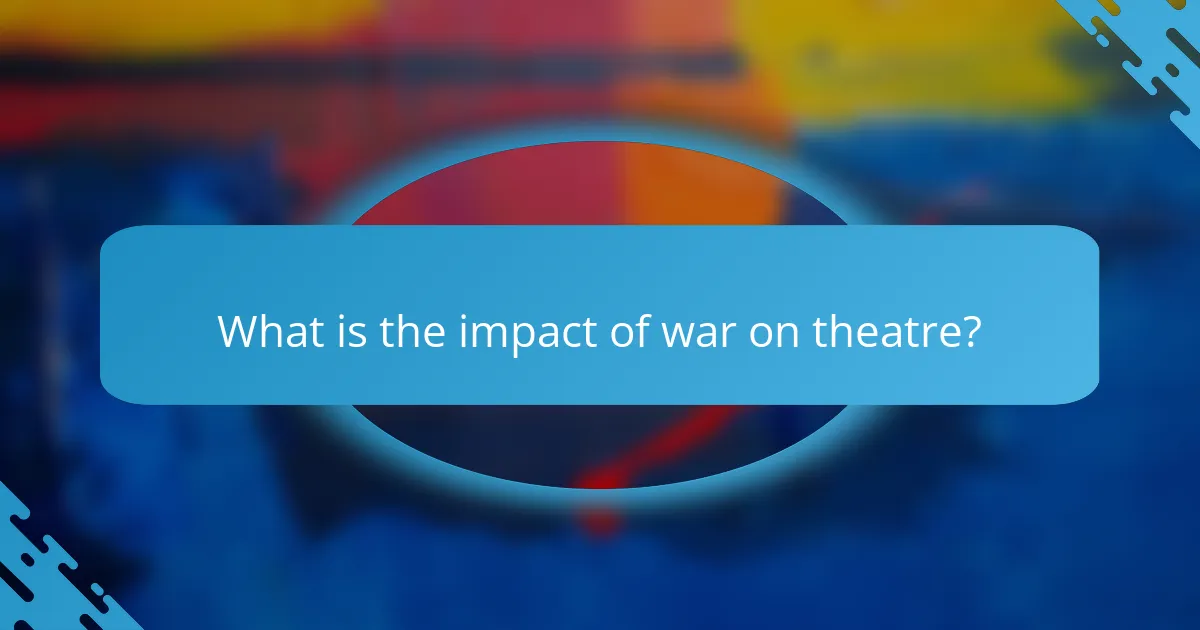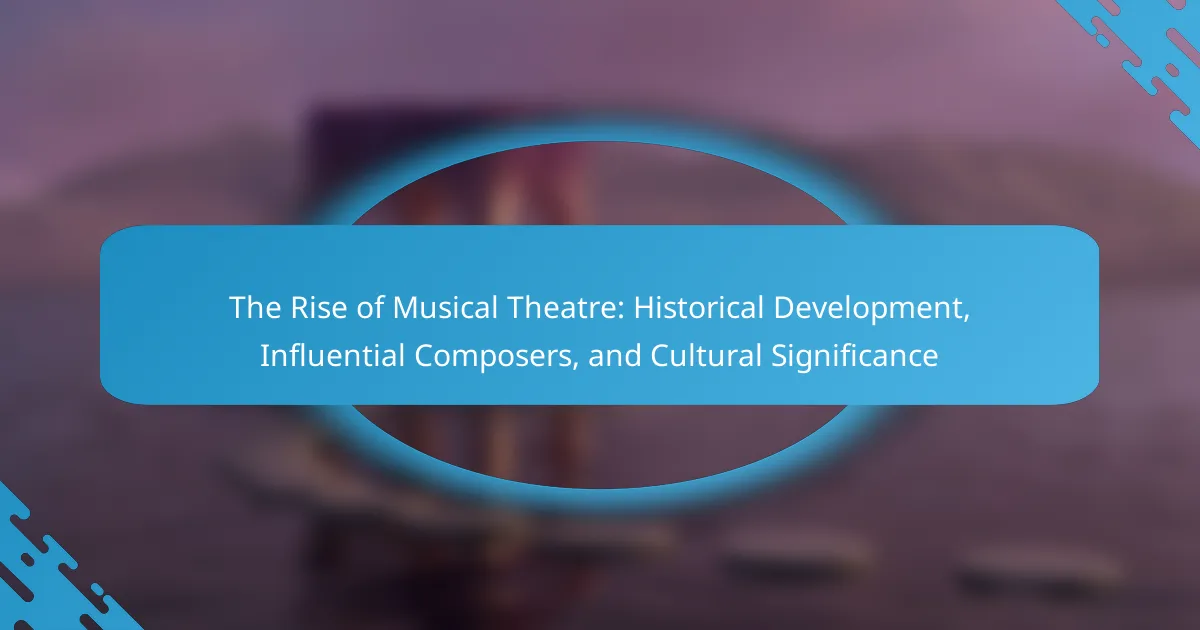The article examines the impact of war on theatre, focusing on how historical events shape themes, styles, and production practices within the performing arts. It highlights the emergence of Absurdist theatre in response to the chaos of World War I and II, as well as the influence of war on minimalist staging due to resource availability. The emotional resonance of war narratives enhances audience engagement and encourages reflection on societal issues. Notable productions, including Bertolt Brecht’s “Mother Courage and Her Children,” are discussed to illustrate these themes. The relationship between war and theatre is presented as a crucial area of exploration in understanding the evolution of theatrical expression.

What is the impact of war on theatre?
War significantly impacts theatre by influencing themes, styles, and production practices. Historical events often serve as backdrops for plays, shaping narratives around conflict and human experience. For instance, World War I and II led to the emergence of Absurdist theatre, reflecting the chaos and disillusionment of the times. Additionally, war can affect the availability of resources for productions, often leading to more minimalist staging. The emotional weight of war stories can deepen audience engagement, prompting reflection on societal issues. Theatre serves as a medium for processing trauma and fostering dialogue about conflict. Various notable productions, such as “Mother Courage and Her Children” by Bertolt Brecht, illustrate these themes effectively. Overall, the interplay between war and theatre remains a significant area of exploration in the performing arts.
How has war historically influenced theatrical productions?
War has historically influenced theatrical productions by shaping themes, narratives, and audience engagement. Theatres often reflect societal issues arising from conflict. For instance, World War I inspired plays like “Journey’s End” by R.C. Sherriff, showcasing the horrors of trench warfare. Similarly, World War II led to works such as “The Diary of Anne Frank,” emphasizing human resilience amidst adversity. The Vietnam War prompted the rise of political theatre, with productions like “Hair” challenging societal norms. Additionally, war has often served as a backdrop for exploring identity and morality. This trend continues in contemporary theatre, where conflicts inform narratives and provoke critical discussions.
What are the key historical examples of theatre responding to war?
Key historical examples of theatre responding to war include “The Trojan Women” by Euripides, which reflects the suffering caused by the Trojan War. “Oh, What a Lovely War!” is a satirical musical that critiques World War I. “Mother Courage and Her Children” by Bertolt Brecht addresses the impact of war on society during the Thirty Years’ War. “The Laramie Project” examines the aftermath of violence and hate, indirectly related to societal conflicts. “War Horse” tells a story of friendship amidst World War I, showcasing the war’s emotional toll. Each of these works illustrates how theatre can comment on and respond to the realities of war.
How have different wars shaped the themes of theatre?
Different wars have significantly shaped the themes of theatre by reflecting societal changes and human experiences. The American Civil War inspired works like “Our American Cousin,” which explored themes of conflict and reconciliation. World War I introduced the theme of disillusionment, evident in plays like “Journey’s End,” highlighting the horrors of trench warfare. World War II brought forth themes of heroism and sacrifice, as seen in “The Diary of Anne Frank,” which depicted the struggles of war-torn lives. The Vietnam War led to a rise in anti-war sentiments in theatre, illustrated by “Hair,” which challenged societal norms. Each conflict has influenced playwrights to address the emotional and psychological impacts of war, shaping the narratives and styles of theatrical productions.
What themes emerge in theatre during wartime?
Theatre during wartime often explores themes of loss, trauma, and resilience. These themes reflect the emotional and psychological impact of conflict on individuals and societies. Loss is depicted through characters mourning loved ones or grappling with the consequences of war. Trauma is illustrated by the struggles of veterans and civilians coping with the aftermath of violence. Resilience showcases the strength of the human spirit in the face of adversity. Historical examples include plays like “Oh What a Lovely War,” which critiques the romanticism of war, and “Mother Courage and Her Children,” highlighting the futility of conflict. These themes serve to engage audiences and provoke thought about the realities of war.
How do themes of conflict and resolution manifest in wartime theatre?
Themes of conflict and resolution are central to wartime theatre. These themes often depict the struggles of individuals and societies during war. Conflict is portrayed through character interactions, showcasing the emotional and physical battles faced. Resolution typically emerges as characters confront their challenges, often leading to personal growth or societal change. Historical examples, such as “Mother Courage and Her Children” by Bertolt Brecht, illustrate the impact of war on human relationships and moral dilemmas. Another example is “All Quiet on the Western Front,” which highlights the futility of war and the search for peace amid chaos. These productions reflect the complex realities of wartime experiences, emphasizing both the destruction of conflict and the hope for resolution.
What role does propaganda play in theatrical narratives during war?
Propaganda serves as a crucial tool in theatrical narratives during war. It shapes public perception and influences attitudes toward the conflict. Theatres often produce plays that promote national unity and morale. These narratives can depict the enemy in a negative light, reinforcing stereotypes. Historical examples include works from World War I and II that glorified soldiers and vilified opponents. Plays like “The Cradle Will Rock” utilized propaganda to address social issues within the war context. Governments frequently supported such productions to ensure alignment with wartime objectives. This strategic use of theatre helped mobilize support and justify military actions.
What notable productions have addressed the impact of war?
Notable productions that have addressed the impact of war include “All Quiet on the Western Front,” “War Horse,” and “Mother Courage and Her Children.” “All Quiet on the Western Front,” based on Erich Maria Remarque’s novel, depicts the harrowing experiences of soldiers during World War I. “War Horse,” adapted from Michael Morpurgo’s novel, explores the bond between a boy and his horse amidst World War I’s chaos. “Mother Courage and Her Children,” written by Bertolt Brecht, critiques the effects of war on individuals and society during the Thirty Years’ War. These productions highlight the emotional and societal consequences of conflict.
Which plays are considered seminal in depicting the effects of war?
“Plays considered seminal in depicting the effects of war include ‘All Quiet on the Western Front’ by Erich Maria Remarque and ‘A Long Day’s Journey into Night’ by Eugene O’Neill. ‘All Quiet on the Western Front’ portrays the harrowing experiences of soldiers in World War I. It illustrates the physical and psychological scars of combat. ‘A Long Day’s Journey into Night’ delves into the personal toll of addiction and loss, often reflecting the backdrop of war’s impact. Another significant work is ‘Mother Courage and Her Children’ by Bertolt Brecht. This play critiques the consequences of war on society and individuals. These plays remain influential in understanding war’s profound effects.”
How have directors and playwrights approached the subject of war in their works?
Directors and playwrights have approached the subject of war through various thematic lenses. They often explore the human cost of conflict and the psychological impact on individuals. Works like “All Quiet on the Western Front” illustrate the futility of war. Other productions, such as “Mother Courage and Her Children,” critique the capitalist motives behind warfare. Directors frequently use stark staging and minimalist set designs to emphasize emotional narratives. Playwrights may incorporate personal stories to humanize the experience of soldiers and civilians. Historical context is crucial; many works reflect the specific wars they address, such as World War I and II. Additionally, contemporary pieces often draw parallels to modern conflicts, highlighting ongoing themes of trauma and resilience. Through these approaches, theatre serves as a platform for reflection on the complexities of war.
How do audiences perceive war-themed theatre?
Audiences perceive war-themed theatre as a powerful medium for exploring complex emotions and societal issues. This genre often evokes strong reactions, ranging from empathy to discomfort. Many viewers appreciate the historical context presented, which can deepen their understanding of past conflicts. Productions like “War Horse” have demonstrated the ability to humanize the experiences of soldiers and civilians alike. The emotional impact is often heightened by the use of multimedia elements and immersive storytelling techniques. Audience engagement can lead to discussions about the moral implications of war. Research indicates that performances can serve as a catalyst for reflection on contemporary issues related to conflict. Overall, war-themed theatre is seen as both an artistic expression and a social commentary.
What emotional responses do war-related productions evoke in audiences?
War-related productions evoke a range of emotional responses in audiences. These productions often elicit feelings of sadness and grief due to the portrayal of loss and suffering. They can also provoke anger and frustration in response to the injustices of war. Audiences may experience empathy for the characters depicted, fostering a deeper understanding of the human cost of conflict. Additionally, such productions can inspire hope and resilience, showcasing the strength of the human spirit amid adversity. Research indicates that immersive storytelling in war-themed theatre enhances emotional engagement, making viewers more likely to reflect on the realities of war. This engagement is supported by studies showing that emotional responses can lead to increased awareness and advocacy regarding war-related issues.
How has audience engagement with war-themed theatre changed over time?
Audience engagement with war-themed theatre has evolved significantly over time. In earlier periods, such as World War I and II, theatre served as a tool for propaganda and morale-boosting. Audiences often engaged with these productions as a means of processing collective trauma. In contrast, contemporary audiences approach war-themed theatre with a more critical perspective. They seek to understand the complexities of conflict rather than simply glorifying it.
Research indicates that modern productions often incorporate diverse narratives, highlighting marginalized voices. This shift reflects broader societal changes in attitudes towards war and its consequences. For example, plays like “War Horse” and “The Things They Carried” engage audiences emotionally, fostering empathy and reflection.
Surveys show increased interest in productions that address the psychological impacts of war. This shift has led to greater audience participation in discussions following performances. Overall, audience engagement has transitioned from passive consumption to active reflection and dialogue about the realities of war.
What lessons can be learned from the intersection of war and theatre?
The intersection of war and theatre reveals lessons about human resilience and the impact of conflict on society. Theatre often serves as a reflection of the human experience during wartime. It highlights the emotional and psychological toll of war on individuals and communities. Historical productions like “Oh What a Lovely War” illustrate the absurdity of conflict. They critique the glorification of war and its consequences. Additionally, theatre can foster empathy and understanding among audiences. It allows for the exploration of diverse perspectives on war. Productions based on true events, such as “The Laramie Project,” demonstrate the real-life impact of violence. These lessons emphasize the importance of storytelling in processing trauma and advocating for peace.
How can contemporary theatre continue to reflect on war’s impact?
Contemporary theatre can continue to reflect on war’s impact by exploring personal narratives of those affected. This includes veterans, families, and civilians. Productions can utilize multimedia elements to enhance storytelling. Engaging with historical documents can provide authenticity to the narratives. Collaborations with organizations supporting veterans can bring real-life experiences to the stage. Workshops and community discussions can inform playwrights about current issues related to war. The use of symbolism and metaphor can convey complex emotions tied to conflict. Additionally, incorporating diverse perspectives can enrich the portrayal of war’s effects. This approach allows for a deeper understanding of the multifaceted impact of war on society.
What best practices can theatre practitioners adopt when addressing war themes?
Theatre practitioners should prioritize authenticity and sensitivity when addressing war themes. They must conduct thorough research on the specific conflicts being portrayed. Understanding the historical and cultural context is essential. Engaging with veterans and affected communities can provide valuable insights. Practitioners should also consider the emotional impact on audiences. They can use diverse perspectives to represent the complexity of war. Incorporating multimedia elements may enhance storytelling. Finally, fostering open discussions post-performance can deepen audience engagement.
The main entity of the article is the impact of war on theatre, encompassing historical context, themes, and notable productions. The article examines how war influences theatrical narratives, shaping themes of conflict, loss, and resilience, while highlighting key historical examples such as “Mother Courage and Her Children” and “All Quiet on the Western Front.” It discusses the role of propaganda in theatre during wartime and the evolving audience engagement with war-themed productions. Additionally, best practices for theatre practitioners addressing war themes are outlined, emphasizing authenticity and sensitivity. Overall, the article provides a comprehensive overview of the interplay between war and theatre throughout history.


